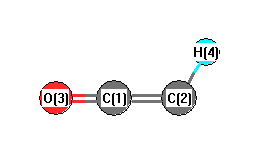Jump to
S1C2
Energy calculated at CCSD/aug-cc-pVTZ
| | hartrees |
|---|
| Energy at 0K | -151.661243 |
| Energy at 298.15K | |
| HF Energy | -151.141970 |
| Nuclear repulsion energy | 52.553079 |
The energy at 298.15K was derived from the energy at 0K
and an integrated heat capacity that used the calculated vibrational frequencies.
Vibrational Frequencies calculated at CCSD/aug-cc-pVTZ
Geometric Data calculated at CCSD/aug-cc-pVTZ
Point Group is C∞v
Cartesians (Å)
| Atom |
x (Å) |
y (Å) |
z (Å) |
|---|
| C1 |
0.000 |
0.000 |
0.020 |
| C2 |
0.000 |
0.000 |
-1.240 |
| O3 |
0.000 |
0.000 |
1.203 |
| H4 |
0.000 |
0.000 |
-2.301 |
Atom - Atom Distances (Å)
| |
C1 |
C2 |
O3 |
H4 |
| C1 | | 1.2603 | 1.1830 | 2.3207 |
C2 | 1.2603 | | 2.4433 | 1.0605 | O3 | 1.1830 | 2.4433 | | 3.5038 | H4 | 2.3207 | 1.0605 | 3.5038 | |
 More geometry information
More geometry information
Calculated Bond Angles
| atom1 |
atom2 |
atom3 |
angle |
|
atom1 |
atom2 |
atom3 |
angle |
| C1 |
C2 |
H4 |
180.000 |
|
C2 |
C1 |
O3 |
180.000 |
Electronic energy levels
Charges, Dipole, Quadrupole and Polarizability
Jump to
S1C1
Energy calculated at CCSD/aug-cc-pVTZ
| | hartrees |
|---|
| Energy at 0K | -151.663808 |
| Energy at 298.15K | |
| HF Energy | -151.141763 |
| Nuclear repulsion energy | 52.418699 |
The energy at 298.15K was derived from the energy at 0K
and an integrated heat capacity that used the calculated vibrational frequencies.
Vibrational Frequencies calculated at CCSD/aug-cc-pVTZ
| Mode Number |
Symmetry |
Frequency
(cm-1) |
Scaled Frequency
(cm-1) |
IR Intensities
(km mol-1) |
Raman Act
(Å4/u) |
Dep P |
Dep U |
|---|
| 1 |
A' |
3357 |
3209 |
41.82 |
|
|
|
| 2 |
A' |
2078 |
1986 |
383.14 |
|
|
|
| 3 |
A' |
1256 |
1201 |
4.17 |
|
|
|
| 4 |
A' |
576 |
550 |
15.95 |
|
|
|
| 5 |
A' |
478 |
457 |
259.07 |
|
|
|
| 6 |
A" |
504 |
482 |
2.53 |
|
|
|
Unscaled Zero Point Vibrational Energy (zpe) 4124.7 cm
-1
Scaled (by 0.9558) Zero Point Vibrational Energy (zpe) 3942.4 cm
-1
See section
III.C.1 List or set vibrational scaling factors
to change the scale factors used here.
See section
III.C.2
Calculate a vibrational scaling factor for a given set of molecules
to determine the least squares best scaling factor.
Geometric Data calculated at CCSD/aug-cc-pVTZ
Point Group is Cs
Cartesians (Å)
| Atom |
x (Å) |
y (Å) |
z (Å) |
|---|
| C1 |
0.000 |
0.054 |
0.000 |
| C2 |
1.071 |
-0.680 |
0.000 |
| O3 |
-1.069 |
0.528 |
0.000 |
| H4 |
2.121 |
-0.468 |
0.000 |
Atom - Atom Distances (Å)
| |
C1 |
C2 |
O3 |
H4 |
| C1 | | 1.2984 | 1.1692 | 2.1847 |
C2 | 1.2984 | | 2.4573 | 1.0711 | O3 | 1.1692 | 2.4573 | | 3.3420 | H4 | 2.1847 | 1.0711 | 3.3420 | |
 More geometry information
More geometry information
Calculated Bond Angles
| atom1 |
atom2 |
atom3 |
angle |
|
atom1 |
atom2 |
atom3 |
angle |
| C1 |
C2 |
H4 |
134.223 |
|
C2 |
C1 |
O3 |
169.533 |
Electronic energy levels
Charges, Dipole, Quadrupole and Polarizability
